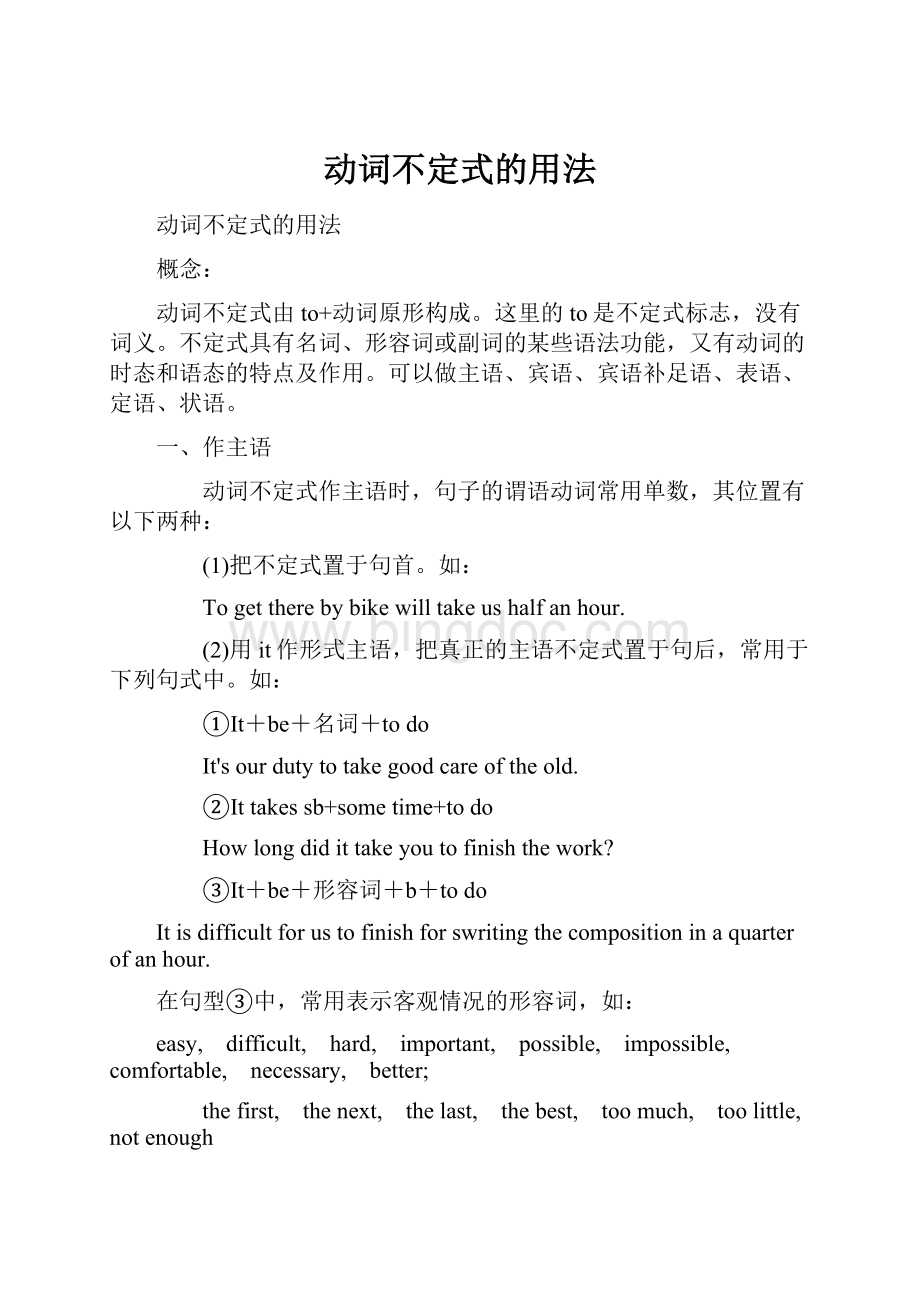动词不定式的用法.docx
《动词不定式的用法.docx》由会员分享,可在线阅读,更多相关《动词不定式的用法.docx(27页珍藏版)》请在冰点文库上搜索。

动词不定式的用法
动词不定式的用法
概念:
动词不定式由to+动词原形构成。
这里的to是不定式标志,没有词义。
不定式具有名词、形容词或副词的某些语法功能,又有动词的时态和语态的特点及作用。
可以做主语、宾语、宾语补足语、表语、定语、状语。
一、作主语
动词不定式作主语时,句子的谓语动词常用单数,其位置有以下两种:
(1)把不定式置于句首。
如:
Togettherebybikewilltakeushalfanhour.
(2)用it作形式主语,把真正的主语不定式置于句后,常用于下列句式中。
如:
①It+be+名词+todo
It'sourdutytotakegoodcareoftheold.
②Ittakessb+sometime+todo
Howlongdidittakeyoutofinishthework?
③It+be+形容词+b+todo
Itisdifficultforustofinishforswritingthecompositioninaquarterofanhour.
在句型③中,常用表示客观情况的形容词,如:
easy, difficult, hard, important, possible, impossible, comfortable, necessary, better;
thefirst, thenext, thelast, thebest, toomuch, toolittle, notenough
④It+be+形容词+ofsb+todo
Itisstupidofyoutowritedowneverythingtheteachersays.
在句型④中,常用careless,clever,good,foolish,honest,kind,lazy,nice,right,silly,stupid,wise rude, clever, foolish, thoughtful, thoughtless(欠考虑的;不考虑的), brave, considerate(考虑周到的), selfish(自私的)等表示赞扬或批评的词。
在不定式前的sb,可看作其逻辑主语。
这一句式有时相当于Sbis+形容词+todo句式,如:
It'skindofyoutohelpmewithmyEnglish.=YouarekindtohelpmewithmyEnglish.
⑤Itseems(appears)+形容词+todo
Itseemedimpossibletosavemoney.
Itseemedselfishofhimnottogivethemanything. 他不给他们任何东西,这显得太自私了。
注意:
1)其他系动词如,look,appear等也可用于此句型
2)不定式作为句子主语时,动词用单数形式。
3)当不定式作主语的句子中又有一个不定式作表语时,不能用Itis…to…的句型
对应性:
Toseeistobelieve. 百闻不如一见。
二、作宾语
1)以下动词后,只能跟不定式作宾语
afford(付得起),agree(同意),aim(力求做到),appear(显得),arrange(安排),ask(要求),attempt(试图),care(想要),choose(决定),claim(声称),condescend(屈尊),consent(准许),decide(决定),demand(要求),determine(决心),endeavor(竭力),expect(期待),fail(未履行),help(帮助),hesitate(犹豫),hope(希望),learn(学会),manage(设法),neglect(疏忽),offer(主动提出),plan(计划),prepare(准备),pretend(假装),proceed(接着做),promise(答应),prove(证明),refuse(拒绝),resolve(解决),seem(觉得好像),swear(发誓),tend(往往会),threaten(威胁),undertake(承诺),volunteer(自愿做),vow(发誓),want(想要),wish(希望)
举例:
Thedriverfailedtoseetheothercarintime.
司机没能及时看见另一辆车。
Ihappentoknowtheanswertoyourquestion.
我碰巧知道你那道问题的答案。
2)动词+疑问词+不定式
decide,know,considerforget,learn,remember,show,understand,see,wonder,hear,findout,explain,tell
Pleaseshowushowtodothat.请演示给我们如何去做。
Therearesomanykindsoftape-recordersonsalethatIcan'tmakeupmymindwhichtobuy.有这么多的录音机,我都拿不定主意买哪一种。
注意:
疑问词带不定式在句中作主语时,谓语动词用单数。
Thequestionishowtoputitintopractice.
问题是怎样把它付诸实施。
3)当复合宾语中的宾语是不定式时,先用形式宾语it代替不定式,把不定式置于补语之后,即:
主语+动词+it+补语+todo句式。
如:
Wethinkitquiteimportantforustolearnaforeignlanguagewell.
Hefeelsithisdutytohelpthepoor.
IfinditdifficulttolearnEnglishwell.
三、作补语
1)动词+宾语+不定式(todo)
advise allow believe cause challenge compel(强迫,使不得不) declare encourage forbid force find hire induce(引诱,劝导)instruct(命令,指示) invite like order permit persuade remind request require select send suppose tell train urge(催促,鼓励)
例句:
a. Fatherwillnotallowustoplayonthestreet.
父亲不让我们在街上玩耍。
b. Webelievehimtobeguilty.
我们相信他是有罪的。
find的特殊用法:
find后可用分词做宾补,或先加形式宾语,再加形容词,最后加带to的动词不定式。
find后也可带一个从句。
此类动词还有get,have。
Ifoundhimlyingontheground.
Ifounditimportanttolearn.
IfoundthattolearnEnglishisimportant.
典型例题:
Thenextmorningshefoundtheman___inbed,dead.
A.lying B.lie C.lay D.laying
答案:
A.find的宾语后面,用分词或分词短语,起宾语补足语作用。
现在分词表达主动,也表达正在进行,过去分词表达被动。
lie:
躺过去式lay,过去分词lain,现在分词lying;
lie:
说谎过去式lied,过去分词lied,现在分词lying;
lay:
安放过去式laid,过去分词laid,现在分词laying;
2)to+be的不定式结构,作补语的动词。
Acknowledge 承认,供认, believe, consider, think, declare(声称), discover,fancy(设想), feel, find, guess, judge, imagine, know, prove, see(理解),show, suppose, take(以为), understand
WeconsiderTomtobeoneofthebeststudentsinourclass.
我们认为汤姆是班上最好的学生之一。
3)tobe+形容词
Seem, appear, besaid, besupposed, bebelieved, bethought, beknown, bereported, hope,wish, desire, want, plan, expect, mean…
Thebookisbelievedtobeuninteresting.
Itisbelievedthat…
人们认为这本书没什么意思。
有些动词需用as短语做补语,如regard,thinkbelieve,take,consider.
WeregardTomasourbestteacher. 我们认为汤姆是我们最好的老师。
Marytookhimasherfather. 玛丽把他当作自己的父亲。
四、作表语
不定式作表语表示具体动作或将来动作;动名词作表语表示抽象的一般行为。
①Tobekindtotheenemyistobecrueltothepeople.
②Mychiefpurposeistopointoutthedifficultiesofthematter.
③WhatIwouldsuggestistoputoffthemeeting.
当主语和表语都是不定式时,其含义一是条件,一是结果(例①)。
当主语是aim,duty,hope,idea,mistake,plan,purpose,suggestion等为中心词的名词词组(例②)时,或以what引导的名词性分句(例③),不定式说明主语的内容。
④Ourworkisservingthepeople.
⑤Whathelikesistakingawalkaftersupper.
⑥ThestorytoldbyMrWangisinteresting.
④⑤句动名词作表语,与主语部分可以转换,如Servingthepeopleisourwork,而⑥句中是现在分词作表语,说明主语的性质、状态,现在分词具有形容词的各种特征,另外,动名词作表语还应与进行时态区别开来。
五、作状语
1)目的状语
To…onlyto(仅仅为了), inorderto, soasto, so(such)…asto…(如此……以便……)
Heransofastastocatchthefirstbus. 他飞快地跑以便赶上第一班车。
Icomehereonlytosaygood-byetoyou. 我来仅仅是向你告别。
2)作结果状语,表事先没有预料到的,要放在句子后面。
Hesearchedtheroomonlytofindnothing.
3) 表原因
I'mgladtoseeyou.
典型例题
Thechairlooksratherhard,butinfactitisverycomfortableto___.
A.sit B.siton C.beseat D.besaton
答案:
B. 如果不定式为不及物动词,其后应有必要的介词。
当动词与介词连用时,常位于"形容词+动词不定式"结构的末尾。
Thewateristoocoldtodrink.(不用被动)
六、作定语
⒈不定式作定语
不定式在句中作定语,置于被修饰的名词或代词之后。
如:
①ThenexttraintoarriveisfromWashington.
②Doyouhaveanythingtobetaken(totake)toyoursister?
③Doyouhaveanythingtosayonthequestion?
④Wouldyoupleasegivemesomepapertowriteon?
⑤MywishtovisitFrancehascometrueatlast.
不定式短语作定语和被修饰词之间表示以下关系:
(1)表示将来的动作(例①)。
(2)与被修饰词之间有动宾关系,如是不及物动词,则需加介词(例④)。
(3)与被修饰词之间有动宾关系,同时与句中其它词之间又有逻辑上的主谓关系时,尽管有被动含义,却仍用主动语态(例③);如只有动宾关系,而无逻辑上的主谓关系,则需用被动语态(例②)。
(4)不定式作定语时,一般可转换为定语从句,例①toarrive=thatwillarrive。
七.省to的动词不定式
介绍
1)情态动词(除ought外,oughtto意思是"应该",是情态动词,只有一种形式,后边接动词不定式,to不能省略。
oughtto没有人称和数的变化,后接动词原形可以表示现在、将来或过去将来,由时间状语或上下文决定。
例如:
Theyoughttocometomorrow.他们明天应当来):
2)使役动词let,have,make:
3)感官动词see,watch,lookat,notice,observe,hear,listento,smell,feel,find等后作宾补,省略to。
注意:
在被动语态中则to不能省掉。
在使役动词中get除外(getsb.todosth.)
Isawhimdance.
=Hewasseentodance.
Thebossmadethemworkthewholenight.
=Theyweremadetoworkthewholenight.
4)表示个人意愿或倾向的wouldrather,hadbetter,might(just)aswell:
ratherthan置于句首时。
Ratherthanrideonacrowdedbus,healwayspreferstorideabike.
5)Why…/whynot…:
6)help可带to,也可不带to,helpsb(to)dosth:
7)but和except:
but前是动词do时,后面出现的动词用不带to的动词不定式。
8)由and,or和than连接的两个不定式,第二个to可以省去:
9)通常在discover,imagine,suppose,think,understand等词后,可以省去tobe:
Heissupposed(tobe)nice. 他应该是个好人。
10)but作介词,后接不定式结构时,前面谓语动词部分若含有do的形式时,but后的不定式要省去to,否则要带to。
Hewantstodonothingbutgoout.
Hewantstobelieveanythingbuttotakethemedicine.
11)当两个或多个不定式短语由连词and,but或or连接时,后一个或几个不定式符号to常省略。
但若表示对比、对照关系时,则不能省略。
HewantstomovetoFranceandmarrythegirl.
Thepurposeofnewtechnologiesistomakelifeeasier,.
nottomakeitmoredifficult.
12)不定式做表语时,一般要带to,但若主语部分中含有do的各种形式时,符号to可省去。
We'vemissedthelastbus.Allwecoulddonowiswalkhome.
典型例题
1)----Iusuallygotherebytrain.
----Whynot___byboatforachange?
A.totrygoing B. tryingtogo C. totryandgo D. trygoing
答案:
D.whynot后面接不带to的不定式,因此选D。
2)Pauldoesn'thavetobemade___.Healwaysworkshard.
A.learn B.tolearn C.learned D.learning
答案:
B.make后接不带to的动词不定式,当其用于被动时,to不可省略。
13,在口语中,为避免重复,常用"to"代替不定式结构,有时甚至可以把to省略.如:
①-DidyougotovisittheGreatWall
-No,Iwantedto,buttherewasn'tenoughtime.
动词不定式的否定式...nottodo...
Tellhimnottoshutthewindow…
ShepretendednottoseemewhenIpassedby.我走过的时候,她假装没看见。
典型例题
1)Tellhim___thewindow.
A.toshutnot B.nottoshut C.tonotshut
D.notshut
答案:
B。
tellsbtodosth的否定形式为tellsbnottodosth.
2) Shepretended___mewhenIpassedby.
A. nottosee B.notseeing C.tonotsee
D. havingnotseen
答案:
A。
pretend后应接不定式。
其否定形式为pretendnottodosth.。
3)Mrs.Smithwarnedherdaughter___afterdrinking.
A.nevertodrive B.toneverdriver
C.neverdriving D.neverdrive
答案:
A。
warnsbtodosth.的否定形式为warnsbnottodosth.此处用的是否定词never.
4)Theboywantedtoridehisbicycleinthestreet,buthismothertoldhim____.
A.notto B.nottodo C.notdoit
D.donotto
答案:
A。
notto为nottodoit的省略形式。
可以只用to这个词,而不必重复整个不定式词组。
及物动词do后应有名词、代词等,否则不对,因此B,D不对。
5)Thepatientwaswarned___oilyfoodaftertheoperation.
A.toeatno B.eatingnot C.nottoeat
D.noteating
答案:
C。
warn一词要求后用不定式,此处为不定式的被动,否定形式为bewarnednottodo。
八、不定式的特殊句型
不定式的特殊句型
soasto
1)表示目的;它的否定式是soasnottodo。
Tomkeptquietabouttheaccidentsoasnottolosehisjob.
汤姆对事故保持沉默是为了不丢掉他的工作。
Goinquietlysoasnottowakethebaby.
轻点进去,别惊醒了婴儿。
2) sokindasto---劳驾
Wouldyoubesokindastotellmethetime?
劳驾,现在几点了。
2、"Whynot+动词原形"表达向某人提出建议
"为什么不……?
""干吗不……?
"
例如:
Whynottakeaholiday?
干吗不去度假?
3、It'sforsb.和It'sofsb.
1)forsb.常用于表示事物的特征特点,表示客观形式的形容词,如easy,hard,difficult, interesting,impossible等:
It'sveryhardforhimtostudytwolanguages.对他来说学两门外语是很难的。
2)ofsb的句型一般用表示人物的性格,品德,表示主观感情或态度的形容词,如good,kind,nice,clever,foolish,right。
It'sveryniceofyoutohelpme.你来帮助我,你真是太好了。
for与of的辨别方法:
用介词后面的代词作主语,用介词前边的形容词作表语,造个句子。
如果道理上通顺用of,不通则用for。
如:
Youarenice. (通顺,所以应用of)。
Heishard. (人是困难的,不通,因此应用for。
)
4、不定式的特殊句型too…to…
1)too…to 太…以至于…
Heistooexcitedtospeak.
他太激动了,说不出话